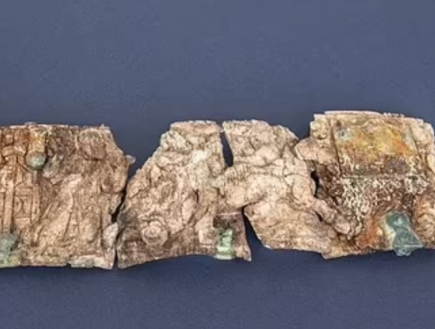Archaeologists have unearthed a remarkable religious relic adorned with Christian motifs within a marble shrine of an early church excavated in Austria. The 1,500-year-old ivory box, depicting scenes such as Moses receiving the Ten Commandments on Mount Sinai, various saints, and the Ascension of Christ, is considered a significant discovery. Due to the rarity of sacred early Christian objects, this find is particularly noteworthy; only about 40 such relics have been discovered globally, with the last significant find occurring nearly a century ago.
The circular-shaped box is a rare artifact from the early days of Christianity, a religion approximately 2,000 years old. This discovery was made by researchers from the University of Innsbruck during the excavation of an early Christian church situated on the Burgbichl in Irschen, southern Austria. The region was historically under Roman control, and the church likely functioned as a pagan sanctuary before being repurposed for Christian worship following Emperor Constantine’s legalization of Christianity in 313 AD and Emperor Theodosius’ declaration of Christianity as the official religion of the Roman Empire in 380 AD.
Gerald Grabherr, the lead archaeologist, expressed the rarity and significance of this discovery, stating, “We know that this only happens once in an archaeologist’s life as a scientist.” The team found a sealing stone in a pit-like depression where an altar once stood. Upon removing the stone, they discovered the broken white marble box. Initially a pure circle, the box was held together by metal and clasped with wood.
The relic is believed to have been the holiest part of the church, raising questions about why it remained among the ruins instead of being taken when the church was abandoned. The box features depictions of men with beards and long robes, illustrating scenes from both the Old and New Testaments. While the scenes are not fully understood, archaeologists speculate that one might depict Moses receiving the laws from God or parting the Red Sea, while another might show the Resurrection of Christ.
Dr. Barbara Kainrath, involved in the research, noted, “The head is turned in a different direction, and with this representation, we can grab [God] handing over the law to Moses.” Another scene appears to depict a figure being pulled up by a hand from the clouds, possibly illustrating an ascension. The presence of horses and a cart wheel in the imagery could reference various Biblical passages involving horses, such as Revelations 19:11 or the Egyptians’ pursuit of Moses and the Israelites.
Despite being found in southern Austria, the box was likely not made there due to the lack of necessary materials in the region. Researchers suggest it may have been crafted in a major urban center like Alexandria, Ravenna, or Aquileia. The box was discovered in several pieces, indicating it might have broken before being placed in the large marble box under the ancient church’s shrine. Dr. Ulrike Tochterle mentioned, “Presumably someone tried to remove the relic. It is very noticeable that parts were missing, from the fittings for example, and also parts of the relief on the outer wall.”
The church, about 60 feet long, featured a marble threshold at its entrance and was surrounded by burials to the south and west. The team uncovered remains believed to be of ‘social upper class’ individuals from the region, now recoverable and examinable in the Natural History Museum in Vienna. The researchers estimate that 200 to 300 people lived in the area between the 3rd and 7th centuries AD.
